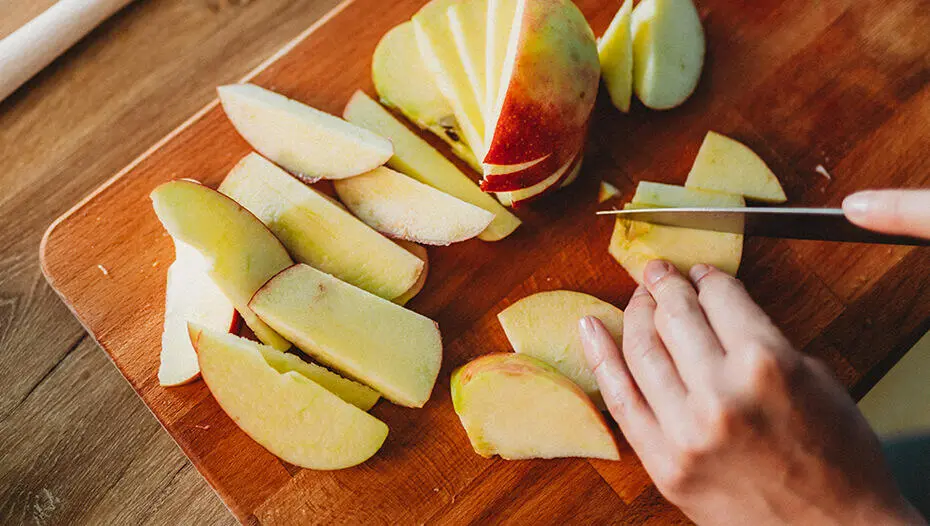It’s not always safe to feed a dog food meant for humans. Some of our best friends, the dogs, could go into serious problems if they ate the wrong component. Some foods are not safe for dogs to eat, and doing so can lead to gastrointestinal distress or even death. Therefore, it is only natural for people to hesitate before giving their pets their favorite food.
It’s easy to see how a dog could eat their weight in apples without their owner realizing it, given how common apples are in our homes, whether baked into a pie or left to ripen on the ground under the apple tree in the backyard.
But, do canines enjoy apple pie? And how do dogs like them? In this piece, we’ll discuss how you can successfully introduce your pet to this tasty treat.
If so, how do they react?
Apples are safe for dogs to eat in moderation. For the most part, your canine friend can enjoy an apple as a treat so long as you keep the seeds and core out of his or her mouth. But if your dog is on a particular diet, overweight, or has diabetes, you should see your vet before giving it an apple (or any other fruit).
You should also know that eating too large of apple slices can cause choking. If you want to give your dog some apple, you should cut it up into small pieces.
When giving your dog its first taste of apple, be sure to keep an eye on it. Keep the fruit bowl out of your pet’s reach and watch for any strange behavior so you can prevent it in the future.
Should I feed my dog apples?
Does the old adage, “An apple a day keeps the vet away,” also hold true for animals? Apples, after all, are packed with nutrients that are good for both humans and canine companions. Antioxidants, vitamins A and C, fiber, and potassium are all examples. If your dog is eating well-balanced, commercial dog food, it likely doesn’t need any more fruit to stay healthy.
However, apples have another benefit for dogs: their crunchy texture can aid in dental hygiene and provide a breath mint.

Apples are great for dogs in many ways, but their owners should be aware that the sugar level of this delicious fruit is not to be overlooked. Therefore, apple should be given to pets only sometimes. Treats should never account for more than 10 percent of your pet’s total daily calorie intake.
Is it OK to feed apples to puppies?
Apples could be the next new food to attempt for the younger dogs in the family. I’ve got some wonderful news for you: Puppies can enjoy apples. Puppies should have no issue munching on an apple so long as the fruit is properly prepared by being cleaned, having the seeds and core removed, and being chopped into little, manageable parts.
It’s important to keep an eye on your dog in case they have an unpleasant response or choke.
When and how to give a dog an apple
If your dog begs for a piece of your apple every time you take a bite, here’s how to give it to him without wasting any of the fruit:
Start by peeling the apple and cutting it in half lengthwise
It is fine to eat with the peel still attached. However, this is where the fruit’s fiber content is highest, and too much fiber can lead to gastrointestinal distress. Those pets with delicate stomachs may benefit from having the peel removed and being fed only in little amounts.
The apples should be diced into manageable pieces. Avoid feeding your pet anything that is excessively huge, as this poses a choking risk.
Apples can be grated or puréed and added to your dog’s regular food.

Are apple seeds poisonous for dogs?
You may have heard that apple seeds contain cyanide which is a poisonous substance for both humans and pets. This is true, but it’s also true that the small quantity found in the seeds of one apple is usually harmless. However, it’s still important to stay on the safe side and remove the seeds before feeding apple to your dog, as cyanide poisoning can be very serious.
If you’re worried your dog has had one too many apples unbeknownst to you, here are some of the most common cyanide poisoning symptoms to watch out for:
- Panting
- Difficulty breathing
- Dilated pupils
Make sure you contact your vet if you notice any of these signs so your dog can get help as soon as possible.
Is your fruit bowl full of other irresistible temptations for a dog looking for their next treat? Find out if dogs can eat oranges, whether dogs and blueberries should be in the same room and what you should do the next time dogs and strawberries meet. You may also want to discover the benefits of adding watermelon to a dog’s diet.